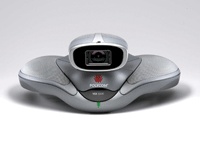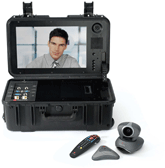The Environmental Protection Agency's decision three years ago to outfit its Emergency Operations Center in Washington with a custom suite of rooms wired with videoconferencing systems from Tandberg of New York paid off when Hurricane Katrina devastated the Gulf Coast last August.For weeks, the EOC's executive conference room'complete with electronic whiteboard, computer integration, audio and video'was in constant use, with staff frequently using two breakout rooms for live meetings with emergency responders in the field.Now EPA is extending the Internet Protocol network to its 10 regional offices so the entire agency can collaborate via voice, video and data internally, and with outside partners.Observers of the government market agree that videoconferencing has become more than a way to avoid the costs and risks of travel, the original driver of demand for the technology.'It's not just a travel alternative,' said Ira Weinstein, a partner at Wainhouse Research of Duxbury, Mass. 'It's an efficiency and productivity tool.'Governments are also eyeing videoconferencing as a tool for continuity planning and telecommuting. More and more federal employees work at home, especially in the congested Washington area, according to the annual telework survey by CDW Government Inc. of Vernon Hills, Ill. Forty-one percent of federal employees responding to the survey indicated that they telework, up from 19 percent last year.Lessons from Katrina and concerns about avian flu are driving agencies to secure remote locations in case large numbers of employees are evacuated. Distance learning is another growth area, say videoconferencing vendors and analysts.While consumer video is a crowded field, the high-end conferencing market consists of barely a half-dozen vendors.Polycom Inc. of Pleasanton, Calif., and Tandberg Inc. of New York dominate the market, according to Wainhouse Research, boasting 43 percent and 24 percent shares, respectively, of worldwide unit shipments in 2005. Sony Electronics Inc. and Aethra Inc. of Miami hold market shares in the high single digits.Among other U.S. firms, LifeSize Communications Inc. of Austin, Texas, is just appearing on the radar as a pioneer of high-definition videoconferencing. Technological advances were waning until LifeSize came along in 2003, Weinstein said.'We've been kind of in maintain mode,' he said. 'LifeSize came in and really stirred the pot. They said, 'We're going to set the standard,' and that's effectively what they did.'With LifeSize promising the first high-definition system (720 pixels and above), the established players scrambled to find an HD strategy, Weinstein said.LifeSize's real breakthrough, he added, was making the camera affordable. This is the hurdle that's keeping Polycom and Tandberg from releasing products, though both have hedged their bets, making their newest high-end products 'HD capable.'Sony reacted fastest, thanks to HD cameras from its broadcast division, though LifeSize officials are quick to point out that at $36,000, the Sony camera/coder-decoder (codec) combination costs three times more than LifeSize Room. Tandberg expects to launch a camera to go with its HD-capable codecs and monitors in the second half of this year that will have a 400-pixel option to boost sharpness on existing hardware.However, skeptics either doubt the need for resolution that shows every bead of sweat on a forehead, or relegate HD to niche applications that clearly benefit from sharper pictures, such as telemedicine, science and facial recognition. They caution that HD normally requires 2 Mbps of bandwidth, while LifeSize's existing video system probably runs at less than half that speed.But Munira Fareed, LifeSize's vice president of marketing, countered that, with LifeSize Room costing about the same as a typical system, there's no reason not to have HD for everyday conferencing.'The product gives you nearly 10 times the quality for about the same price,' Fareed said, adding the HD runs at 1 Mbps. HD has other benefits for conferencing, she said, including the widescreen aspect ratio. 'You can see the whole room. You don't need to keep moving the camera.'Fareed listed the National Science Foundation and National Institutes of Health as LifeSize customers.The parallel evolution to IP telephony cuts the cost of videoconferencing by moving it off its traditional channel'costly and unreliable Integrated Services Digital Network lines and simplifying call control, while adding features such as call waiting.'The first and probably biggest benefit of IP is reliability,' Weinstein said, adding that the always-on nature of IP brings centralized management to videoconferencing and takes the surprise out of systems that had a 40-percent failure rate in some organizations.'The big thing that has plagued [ISDN] videoconferencing was dropped calls,' he said.In addition, vendors report increased use of the H.239 standard from the International Telecommunication Union. The standard lets data and video pass over the same stream, so videoconference participants can simultaneously view electronic whiteboards, spreadsheets and PowerPoint presentations.[IMGCAP(2)]Meanwhile, Session Initiation Protocol continues to emerge as what Weinstein calls a lightweight alternative to the older, handshake-heavy H.323 standard for videoconferencing over IP.Joel Brunson, president of Tandberg Federal, said SIP 'is not complete yet. It's in flux right now.' Most conference-room hardware supports both standards, and Brunson termed the current situation a Beta vs. VHS-like competition.Though the standards front is relatively quiet, usability and security recently took a large step forward when several vendors standardized how their products traverse network address translation and firewalls.In the past, videoconferencing links often failed as networks rejected data entering from outside. A new NAT/firewall standard, H.460, minimizes the need to have a traversal device at every network.'It's going to help companies get through not only their own firewall but the firewall of the people they're trying to call,' Weinstein said.Laura Shay, Polycom's senior product marketing manager, said, 'Now the individual user who before couldn't participate in the videoconference because they didn't have a NAT/firewall solution can participate from their home, for example.' She added that most of Polycom's products support H.460. LifeSize and Tandberg officials make similar claims.The accompanying product list on Page 28 shows the three main configuration choices. Set-top systems are appliances that contain the two required ingredients for any videoconference: the codec, which converts video and audio signals for transmission, and the camera. You can use them with almost any monitor that accepts standard video, such as NTSC/PAL.Sometimes, codec and camera are separated in flexible configurations, such as a wall-mounted plasma screen with codec, and the camera on the table. All-in-one systems build the codec and camera into the monitor, and can rest on a table or a specially designed pedestal or other surface, sometimes outfitted with wheels.Audio input is typically through a speakerphone or microphone near the participants. The major vendors also sell standalone codecs, but these are geared to integrators who assemble systems.One vendor, Tandberg, has sold a ruggedized, suitcase-size mobile unit, the Tandberg Tactical MXP, for several years, and Polycom released its version, the Mobile Responder, in January.'We have a lot of interest from the [Defense Department] agencies, including the Army, as well as NATO,' said Shay.Both Tandberg and Polycom cite strong interest from first responders. Aethra also has a mobile unit, the Voyager Star.Among the more common optional equipment are bridges (also called multipoint control units or MCUs), which allow conferencing between more than two sites and, in high-end systems, are often built into the codec. Network gateways help systems connect over disparate network protocols, such as ISDN or even the 3G cellular standard, which is becoming popular in Europe and Asia and just coming online in North America.Polycom and Tandberg both claim significant government sales and package some models explicitly for the public sector, especially public safety and judiciary.Tandberg's judicial line, for example, is gaining acceptance in the Federal Bureau of Prisons and, according to Brunson, some court systems for use in remote testimony and visitations.Building the highest-quality system requires looking beyond the video devices.'The room and the [audio/video] system that the system connects to are just as important as the videoconferencing hardware itself,' said David Raden, chief technology officer of Audio Video Systems Inc., a Washington-area integrator.Raden said that while most codecs come with echo cancellation and noise reduction, and can handle conferences of two or three people, rooms for larger conferences may have to be fitted with distributed microphones and sound-absorption panels.The most sophisticated rooms even have sound mixers like those used in recording studios, he said. Anyone seeking to construct or convert a room for videoconferencing should also look for quiet air handling, and even dimmable lights that can also be angled for proper lighting of faces.As for network bandwidth, Raden said standard 100Base-T Ethernet is fine, thanks in large part to recent advances in video compression, including the widespread availability of the H.264 standard.Vendors and integrators alike recommend taking a holistic view of what it costs to run a videoconferencing system. Besides spending tens of thousands of dollars for the hardware, be prepared to invest in training, installation and service.'Rely on your reseller,' Weinstein said.
Polycom's VSX 5000 videoconferencing system works best for small to medium-sized rooms. It sells for $3,999.
POLYCOM'S MOBILE Responder videoconferencing system, starting at $19,995, comes with a ruggedized, FAA-approved case with wheels, and an integrated speaker and microphone.
High-end players a select few
Moving to IP
Buying advice
David Essex is a freelance technology writer based in Antrim, N.H.








